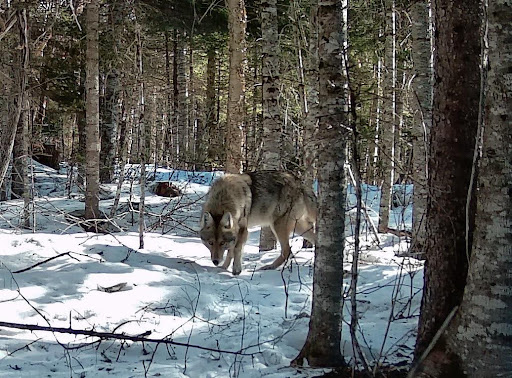Wildlife related ecotourism, aka “wildlife watching” in Maine generates well over $1 billion in annual economic activity. This is more economic benefit to Mainers than from fishing and hunting combined. In and around Yellowstone Park, wolf watchers spend some $35 million annually, boosting the local economies and providing jobs that rely on non-consumptive wildlife use. Closer to home, Ontario’s Algonquin Park has hosted public wolf howls for years that have attracted thousands of visitors. With its proximity to wolf range in Canada and its tens of thousands of square miles of potential wolf habitat, Maine stands poised to benefit from natural wolf recolonization, both ecologically and economically.
In 2019, volunteers from the Maine Wolf Coalition (MWC) collected a wolf scat in northern Maine. This was the first ever DNA documented physical evidence of a live Maine wolf. The animal was an Eastern wolf, a small wolf which inhabits southern Ontario and Quebec. Its closest populations to the northeast U.S. are just sixty miles from New York and seventy-five miles from Maine.

In 2019, after years of unsuccessfully urging the state and federal governments to assess the status of wolves in the northeast, MWC began collecting scat and taking trail camera photos of Maine canids. Presently, they have more than two hundred scats awaiting DNA analysis for which they are seeking funding. Below are four photos of large canids ranging from the Maine/New Hampshire border to far northern Maine.
What is often called the eastern coyote differs from their western counterpart. From the Great lakes through the Canadian Maritimes and New England, all of these animals are either western coyote/wolf hybrids or eastern wolves. During the late 19th and early 20th centuries (coinciding with the extermination of wolves in the United States but not in Canada), coyotes extended their range from the western U.S., moving east. Some of these coyotes mated with smaller Eastern wolves north of the St. Lawrence River. Their hybrid descendants crossed the river and were first documented in New York State over a century ago. Coyote/wolf hybrids now live throughout the northeast and maritime Canada north through Labrador.

In 1993, a young female wolf was killed in Maine by a Pennsylvania bear hunter and MWC was formed in 1994 in response. Since 1993, numerous other wolves have been killed in the U.S. and Canada south of the St. Lawrence (read about documented wolf sightings in the Northeast). While coyote/wolf hybrids will likely always greatly outnumber wolves in Maine, evidence is mounting that wolves are recolonizing Maine and much of the northeast. We may have Eastern wolves, gray wolves or eastern/gray wolf hybrids. Eastern wolves formerly lived in Maine and are now surviving in small numbers just north of the U.S. border in Ontario and Quebec. They range in weight from 45-75 pounds which overlaps with the largest coyote/wolf hybrids, making them impossible to distinguish in the field. Gray wolves range from 60-100+ pounds. An 85 pound Great Lakes gray wolf was killed by a hunter in central New York in 2021.
Wolves do not require wilderness but they do require larger territories than coyote/wolf hybrids and they typically eat larger prey. Therefore, their numbers and population density would likely be much less than coyote/wolf hybrids. Most young wolves leave their packs in search of their own territory and to start a family. They have been documented to travel over 1,000 miles during dispersal, which makes Maine well within range for wolves dispersing from Canada.

The purpose of this article is to draw the attention of Maine guides and the ecotourism industry to the great potential for wolf-related ecotourism in Maine. With the state’s proximity to northeast population centers and to established wolf territory in Canada, and our expansive northern forest providing habitat and prey, there are opportunities to take advantage of the economic opportunity that wolf-related ecotourism could provide. Tourists coming to Maine can be in New York City in the morning and in wolf country that same evening.
Science and growing physical evidence tell us that wolves are in Maine. What is needed is a citizen-based effort to advocate on behalf of wolves and their potential benefits to Maine’s economy and ecology.
Member submitted article by:
John M. Glowa, Sr. – President and Founder of the Maine Wolf Coalition, Inc.

